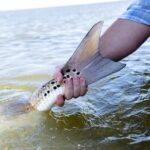
A Veteran Guide’s View of Jacks
If you’ve spent any time on the water in South Florida, chances are you’ve heard
Do you remember your driver’s test? How nervous were you when the instructor pulled out the clipboard and you checked your mirrors five times? There is a very similar dynamic when commercial boats have observers on board. As an aspiring driver, you will put that blinker on ahead of time, constantly check your speed, and be on your best behavior. The numbers we will review in this blog are the Louisiana menhaden reduction fishery’s driver’s test.
A 2024 study, “Characterization of Bycatch for the Menhaden Purse Sein Fishery Occurring off the Coast of Louisiana,” was recently presented at a Louisiana Department of Wildlife and Fisheries meeting. In short, the low bar for dead bycatch from these operations is 145 million individual fish. Note that this bycatch happens during the annual harvest of over 3 billion (yes, billion) menhaden. The study, led by LGL Fisheries observers and funded by the Gulf States Marine Fisheries Commission, is scientifically solid. It sampled over 3% of 2024 sets across Louisiana and adjacent federal waters. It used a stratified-random approach over seven months (April-October) at three plants (Empire, LA; Abbeville, LA; Moss Point, MS). Teams of 4-6 observers per set used nets and high-speed cameras, with estimation methods (design-based and model-based using Generalized Additive Mixed Models) validated by bootstrapping.
The study’s methodology was undoubtedly an impressive research effort. The researchers performed the most comprehensive bycatch study on the reduction fishery that has ever been done. We should also note a few dynamics of this research. First, the observers were present for 3.2% of the total net sets for the year, which equates to 418 of 13,144 total sets. What would you do if you knew that observers were going to be on your vessel and it was for a bycatch study that could ruffle a lot of feathers? The fishermen likely adjusted their behavior, avoiding high-bycatch zones and skewing results. A camera on every set could track billions of fish interactions annually, offering unbiased insight, unlike this 4% snapshot.
This new research comes to light shortly after significant advocacy efforts in Louisiana led to the first redfish regulation changes since 1988. Our position was clear: 3 fish in the slot, no guide limits, and no harvest of bull redfish, which would translate into a 16-year rebuilding timeline. Through public trial, the State landed on a 4-fish limit, no guide limit, and no bull redfish harvest. While it may be surprising, a one-fish difference in bag limit changes the rebuilding timeline to almost 40 years. That change came about at the last minute and was accompanied shortly after by a campaign for an additional 1/4 mile shoreline buffer for the menhaden fleet. Let’s call a spade a spade: this was a backroom tradeoff. Certain individuals and organizations touted the “successful conservation effort to push the pogy boats off the shores!” to shroud their anti-conservation campaigns to add another fish to the bag limit.

It’s hard to review this latest bycatch study and not feel embarrassed for anyone who believed these buffer zone campaigns. This operation killed over 3 billion menhaden. They have no cap or quota. They can expand their harvest to 4 or 5 billion menhaden next year. Nothing is holding them back from legally doing so – and that bycatch “bare minimum estimate” will still fall between 100-200 million fish. Any group that promoted that a buffer would save redfish lied to you. Here’s a quote from the report:
“Commercial purse seine gear utilized by the industry varies by fishing vessel but generally consists of a 1,000-1,400 ft long and 65-90 ft deep purse seine with 1 ¾ inch mesh size. Net materials also differ between fishing vessels, consisting of nylon fiber or high-strength polyethylene fiber (e.g., Dyneema®), or a combination of both, with higher-strength materials typically being used in the net bunts. During fishing operations, nets are deployed by the two purse boats, each one carrying and releasing half of the purse net. Purse boats are directed to the school of menhaden by fish-spotting aircraft overhead, or by spotters in the wheelhouse of the fishing vessel.“

The most net sets occurred in about 16 feet of water. The industry told us explicitly that their nets are designed for significantly deeper water. What are the results of using a purse seine with 65-90’ deep nets in shallow water? 80 million croaker, 11 million spot, and almost 10 million catfish per year become another bycatch statistic. Any purse seine catching millions of bottom-dwelling catfish should be a major red flag. These nets should not be deployed in water this shallow. A purse seine is designed to be closed on the bottom (purse) post-deployment. This design allows for bycatch to escape from the bottom. If the walls of the nets sit on the bottom in shallow water, the result is 80 million pounds of croaker bycatch per year. This research does not give us insights into how bycatch rates would change or what species would be significantly impacted if these operations were moved to more appropriate depths.
Removing so many menhaden—key prey for larger fish, birds, and marine mammals— throws the ecosystem off balance. Evidence points to a rise in jellyfish when menhaden numbers drop, with jellyfish preying on red drum larvae and poorly transferring protein up the food chain. The reduction menhaden fishery operates unchecked without a quota to limit the take. An additional 1/4 mile buffer, meant as a safeguard, seems to do nothing to curb this impact. This industry has cascading impacts on our natural resources. This jellyfish phenomenon has been documented in California as well as South America. Menhaden and sardines eat jellyfish larvae. When you remove filter-feeding forage species, jellyfish take over. Frankly, jellyfish are almost worthless for protein transfers in the ecosystem compared to menhaden. Moon jellyfish prey on planktonic stage fish and studies in other systems have shown jellyfish can significantly reduce the survival of fish larvae in nursery habitats like estuaries.

Bycatch (the accidental catch of non-target species) is a significant issue in this fishery. This report identifies three types: rollover (released over the cork line after pumping), chute (separated by excluder grates), and retained (smaller fish mixed with menhaden in holds). Across 415 sampled sets, observers found 43 species in rollover bycatch (averaging 11 fish per set) and 62 in retained bycatch (averaging 59.8 fish per sampling cage), with chute data less clear. Key species include red drum, cownose rays, blacktip sharks, bull sharks, Atlantic croaker, sand seatrout, spot, and white shrimp, making up 84% of the retained bycatch by number and 51% by weight. Another significant finding that should concern conservationists is the 2% survival rate for redfish that enter the vessel. In layman’s terms, the redfish can be removed from the net and not sucked up through the hose; they have a great chance of survival. If we know this, why are any redfish getting sucked up in the vacuum hose? A 4% bycatch rate might sound small, but when applied to a 3 billion fish harvest, it is a staggering 145 million individual fish.
The menhaden reduction fishery’s ecological toll demands action. A quota could balance economics and ecosystem health. Adjusting netting to match purse seine norms (targeting specific depths) may reduce the catch of tens of millions of fish yearly. Switching to cameras would provide real-time data on every set, guiding policy with higher accountability. The 2025 LGL Bycatch Report, backed by industry and science, shows an unrestricted fishery that needs significant refinement. We must push for reforms to safeguard the Gulf’s biodiversity and economy.
Removing 3 billion fish a year from a single area is simply unacceptable.

If you’ve spent any time on the water in South Florida, chances are you’ve heard

Photo Credit: Graham Tayloe Big Win for Redfish in Alabama Huge news from the Marine

Feature Photo: Carter Abramson | Simms Fishing at the Fisheries Science Symposium We have more

Each year, hundreds of millions of fish are killed as collateral damage from large-scale, inshore
We rely on our members and donations to keep fighting for a sustainable tomorrow in marine conservation.
GIVE THE GIFT OF FISHERIES CONSERVATION THIS HOLIDAY SEASON. SHOP ASGA GOODS THAT FUND FISHERIES RESEARCH & ADVOCACY CAMPAIGNS
JOIN ASGA IN CALLING FOR CRITICAL MANAGEMENT ACTION AFTER YEARS OF SPAWN FAILURES & POOR MANAGEMENT.
By using this website, you agree to our use of cookies. We use cookies to provide you with a great experience and to help our website run effectively. To learn more, please review our privacy policy.